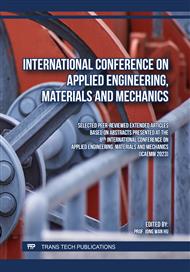[1]
M. Kampa and E. Castanas, "Human health effects of air pollution," Environmental Pollution, vol. 151, no. 2, p.362–367, Jan. 2008.
DOI: 10.1016/j.envpol.2007.06.012
Google Scholar
[2]
P. F. Duffney, L. W. Stanek, and J. S. Brown, "Air pollution: Sources, regulation, and health effects," in Reference Module in Biomedical Sciences, Elsevier, 2023.
DOI: 10.1016/B978-0-12-824315-2.00754-5
Google Scholar
[3]
"Air Pollution." Accessed: Apr. 26, 2023. [Online]. Available: https://education.nationalgeographic.org/resource/air-pollution
Google Scholar
[4]
"Industry." Accessed: Apr. 27, 2023. [Online]. Available: https://www.eea.europa.eu/en/topics/in-depth/industry
Google Scholar
[5]
R. Munsif et al., "Industrial Air Emission Pollution: Potential Sources and Sustainable Mitigation," in Environmental Emissions, IntechOpen, 2021.
DOI: 10.5772/intechopen.93104
Google Scholar
[6]
O. US EPA, "What are Hazardous Air Pollutants?" Accessed: Apr. 28, 2023. [Online]. Available: https://www.epa.gov/haps/what-are-hazardous-air-pollutants
Google Scholar
[7]
E. K. Vakkilainen, "Industrial Applications of Steam Generated from Biomass," in Comprehensive Renewable Energy (Second Edition), T. M. Letcher, Ed., Oxford: Elsevier, 2022, p.299–329.
DOI: 10.1016/B978-0-12-819727-1.00050-9
Google Scholar
[8]
H. Zhao, "Biomass burning emission and impacts on air pollution in China," in Asian Atmospheric Pollution, R. P. Singh, Ed., Elsevier, 2022, p.335–347.
DOI: 10.1016/B978-0-12-816693-2.00024-X
Google Scholar
[9]
J. Chen et al., "A review of biomass burning: Emissions and impacts on air quality, health and climate in China," Science of The Total Environment, vol. 579, p.1000–1034, Feb. 2017.
DOI: 10.1016/j.scitotenv.2016.11.025
Google Scholar
[10]
R. Ghasemi et al., "A comparison of biofiltration performance based on bacteria and fungi for treating toluene vapors from airflow," AMB Express, vol. 10, no. 1, p.8, Jan. 2020.
DOI: 10.1186/s13568-019-0941-z
Google Scholar
[11]
M. A. Fulazzaky, A. Talaiekhozani, M. Ponraj, M. Z. Abd Majid, T. Hadibarata, and A. Goli, "Biofiltration process as an ideal approach to remove pollutants from polluted air," Desalination and Water Treatment, vol. 52, no. 19–21, p.3600–3615, Jun. 2014.
DOI: 10.1080/19443994.2013.854102
Google Scholar
[12]
D. Mussatti, P. Hemmer, and E. H. Pechan, "Chapter 2 Wet Scrubbers for Particulate Matter".
Google Scholar
[13]
N. de Nevers, Air Pollution Control Engineering: Third Edition. Waveland Press, 2016.
Google Scholar
[14]
B. G. Miller, "Emissions Control Strategies for Power Plants," in Coal Energy Systems, B. G. Miller, Ed., in Sustainable World. , Burlington: Academic Press, 2005, p.283–392.
DOI: 10.1016/B978-012497451-7/50006-1
Google Scholar
[15]
M. A. M. Costa et al., "Evaluation of the efficiency of a Venturi scrubber in particulate matter collection smaller than 2.5 µm emitted by biomass burning," Environ Sci Pollut Res, vol. 30, no. 4, p.8835–8852, Jan. 2023.
DOI: 10.1007/s11356-022-22786-3
Google Scholar
[16]
H. D. Hesketh, Wet Scrubbers, 2nd ed. New York: Routledge, 2017.
DOI: 10.1201/9780203733899
Google Scholar
[17]
M. Amin et al., "Size-Segregated Particulate Mass and Carbonaceous Components in Roadside and Riverside Environments," Applied Sciences, vol. 11, no. 21, Art. no. 21, Jan. 2021.
DOI: 10.3390/app112110214
Google Scholar
[18]
G. Shen et al., "Influence of fuel moisture, charge size, feeding rate and air ventilation conditions on the emissions of PM, OC, EC, parent PAHs, and their derivatives from residential wood combustion," Journal of Environmental Sciences, vol. 25, no. 9, p.1808–1816, Sep. 2013.
DOI: 10.1016/S1001-0742(12)60258-7
Google Scholar
[19]
S.-H. Byeon, B.-K. Lee, and B. Raj Mohan, "Removal of ammonia and particulate matter using a modified turbulent wet scrubbing system," Separation and Purification Technology, vol. 98, p.221–229, Sep. 2012.
DOI: 10.1016/j.seppur.2012.07.014
Google Scholar
[20]
B.-K. Lee, B. R. Mohan, S.-H. Byeon, K.-S. Lim, and E.-P. Hong, "Evaluating the performance of a turbulent wet scrubber for scrubbing particulate matter," Journal of the Air & Waste Management Association, vol. 63, no. 5, p.499–506, May 2013.
DOI: 10.1080/10962247.2012.738626
Google Scholar
[21]
S. Yang, Z. Zhu, F. Wei, and X. Yang, "Carbon nanotubes / activated carbon fiber based air filter media for simultaneous removal of particulate matter and ozone," Building and Environment, vol. 125, p.60–66, Nov. 2017.
DOI: 10.1016/j.buildenv.2017.08.040
Google Scholar
[22]
J. Z. Duran and E. B. Caldona, "Design of an activated carbon equipped-cyclone separator and its performance on particulate matter removal," Particulate Science and Technology, vol. 38, no. 6, p.694–702, Aug. 2020.
DOI: 10.1080/02726351.2019.1607637
Google Scholar



